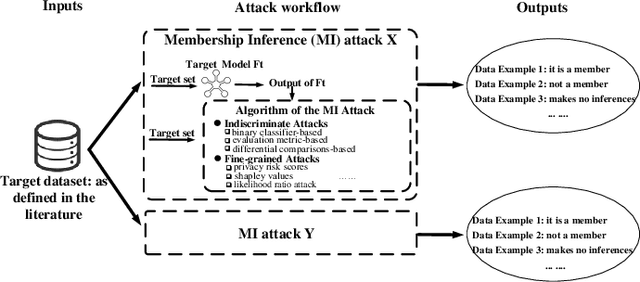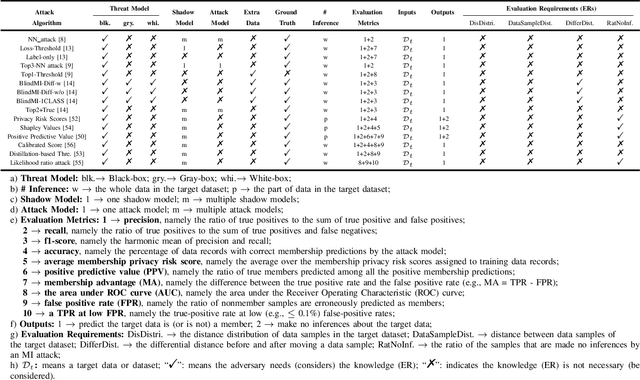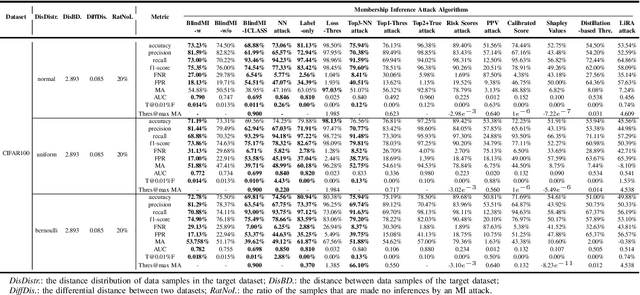Jun Niu
SoK: Comparing Different Membership Inference Attacks with a Comprehensive Benchmark
Jul 12, 2023



Abstract:Membership inference (MI) attacks threaten user privacy through determining if a given data example has been used to train a target model. However, it has been increasingly recognized that the "comparing different MI attacks" methodology used in the existing works has serious limitations. Due to these limitations, we found (through the experiments in this work) that some comparison results reported in the literature are quite misleading. In this paper, we seek to develop a comprehensive benchmark for comparing different MI attacks, called MIBench, which consists not only the evaluation metrics, but also the evaluation scenarios. And we design the evaluation scenarios from four perspectives: the distance distribution of data samples in the target dataset, the distance between data samples of the target dataset, the differential distance between two datasets (i.e., the target dataset and a generated dataset with only nonmembers), and the ratio of the samples that are made no inferences by an MI attack. The evaluation metrics consist of ten typical evaluation metrics. We have identified three principles for the proposed "comparing different MI attacks" methodology, and we have designed and implemented the MIBench benchmark with 84 evaluation scenarios for each dataset. In total, we have used our benchmark to fairly and systematically compare 15 state-of-the-art MI attack algorithms across 588 evaluation scenarios, and these evaluation scenarios cover 7 widely used datasets and 7 representative types of models. All codes and evaluations of MIBench are publicly available at https://github.com/MIBench/MIBench.github.io/blob/main/README.md.
Robust Deep Compressive Sensing with Recurrent-Residual Structural Constraints
Jul 15, 2022



Abstract:Existing deep compressive sensing (CS) methods either ignore adaptive online optimization or depend on costly iterative optimizer during reconstruction. This work explores a novel image CS framework with recurrent-residual structural constraint, termed as R$^2$CS-NET. The R$^2$CS-NET first progressively optimizes the acquired samplings through a novel recurrent neural network. The cascaded residual convolutional network then fully reconstructs the image from optimized latent representation. As the first deep CS framework efficiently bridging adaptive online optimization, the R$^2$CS-NET integrates the robustness of online optimization with the efficiency and nonlinear capacity of deep learning methods. Signal correlation has been addressed through the network architecture. The adaptive sensing nature further makes it an ideal candidate for color image CS via leveraging channel correlation. Numerical experiments verify the proposed recurrent latent optimization design not only fulfills the adaptation motivation, but also outperforms classic long short-term memory (LSTM) architecture in the same scenario. The overall framework demonstrates hardware implementation feasibility, with leading robustness and generalization capability among existing deep CS benchmarks.
End-to-End JPEG Decoding and Artifacts Suppression Using Heterogeneous Residual Convolutional Neural Network
Jul 01, 2020



Abstract:Existing deep learning models separate JPEG artifacts suppression from the decoding protocol as independent task. In this work, we take one step forward to design a true end-to-end heterogeneous residual convolutional neural network (HR-CNN) with spectrum decomposition and heterogeneous reconstruction mechanism. Benefitting from the full CNN architecture and GPU acceleration, the proposed model considerably improves the reconstruction efficiency. Numerical experiments show that the overall reconstruction speed reaches to the same magnitude of the standard CPU JPEG decoding protocol, while both decoding and artifacts suppression are completed together. We formulate the JPEG artifacts suppression task as an interactive process of decoding and image detail reconstructions. A heterogeneous, fully convolutional, mechanism is proposed to particularly address the uncorrelated nature of different spectral channels. Directly starting from the JPEG code in k-space, the network first extracts the spectral samples channel by channel, and restores the spectral snapshots with expanded throughput. These intermediate snapshots are then heterogeneously decoded and merged into the pixel space image. A cascaded residual learning segment is designed to further enhance the image details. Experiments verify that the model achieves outstanding performance in JPEG artifacts suppression, while its full convolutional operations and elegant network structure offers higher computational efficiency for practical online usage compared with other deep learning models on this topic.
 Add to Chrome
Add to Chrome Add to Firefox
Add to Firefox Add to Edge
Add to Edge